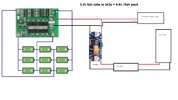eduardo_gj1
Member
Hello, in advance I would appreciate all the help you can give me with this DIY project that I have in mind.
My problem is that when I go out to a gig I have to take various devices for my guitar and among those is my power supply for the guitar pedals.
I have several 18650 cells that were going to be discarded at work because they no longer charge, and it is only the bms or some cell that is damaged.
my doubts so far is regarding the BMS:
Lithium battery protection board 3S 11.1V 12.6V 25A PCB 18650 with scale
link:
I would connect 3s3p for about 9.6v and 15ah, I have that solved and how to select the batteries and charge and test them. now most of the pedals work with 9v and the amp hour when they are analog pedals does not exceed 0.3ah so it would have a good range of hours of use with a pedalboard of about 10 pedals. some pedals like the digital ones use more amp hours I think some have a consumption of 1ah (I'm not sure I should check)
Well now my doubt with the bms:
I am not very clear about the charging and discharging part, I mean in the same charge towards the batteries I could connect the modules: DC-DC XL4015 Adjustable Step-down Buck Converter 4~38V to 1.25-36v Voltage Regulator Module to lower the voltage to 9v (regular consumption of guitar pedals).
link:
And can I connect the battery charger while using the pedals, I mean use battery charge and discharge at the same time? I do not know if I explain myself very well
My problem is that when I go out to a gig I have to take various devices for my guitar and among those is my power supply for the guitar pedals.
I have several 18650 cells that were going to be discarded at work because they no longer charge, and it is only the bms or some cell that is damaged.
my doubts so far is regarding the BMS:
Lithium battery protection board 3S 11.1V 12.6V 25A PCB 18650 with scale
link:
Lithium Batterie Schutzplatine 3S 11,1 V 12,6 V 25 A PCB 18650 mit Waage: Amazon.de: Gewerbe, Industrie & Wissenschaft
Lithium Batterie Schutzplatine 3S 11,1 V 12,6 V 25 A PCB 18650 mit Waage: Amazon.de: Gewerbe, Industrie & Wissenschaft
www.amazon.de
I would connect 3s3p for about 9.6v and 15ah, I have that solved and how to select the batteries and charge and test them. now most of the pedals work with 9v and the amp hour when they are analog pedals does not exceed 0.3ah so it would have a good range of hours of use with a pedalboard of about 10 pedals. some pedals like the digital ones use more amp hours I think some have a consumption of 1ah (I'm not sure I should check)
Well now my doubt with the bms:
I am not very clear about the charging and discharging part, I mean in the same charge towards the batteries I could connect the modules: DC-DC XL4015 Adjustable Step-down Buck Converter 4~38V to 1.25-36v Voltage Regulator Module to lower the voltage to 9v (regular consumption of guitar pedals).
link:
And can I connect the battery charger while using the pedals, I mean use battery charge and discharge at the same time? I do not know if I explain myself very well


